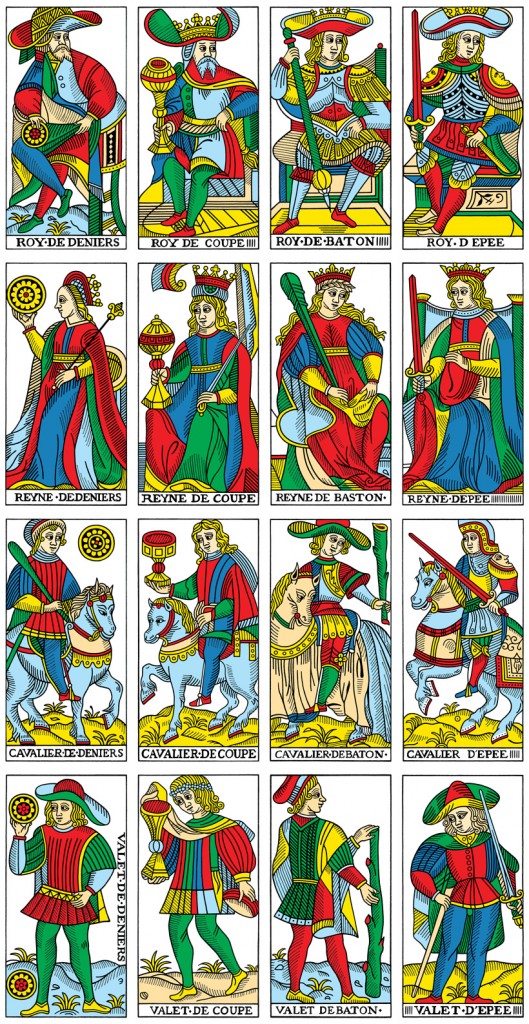Table and Image – section from Chapter 9: The Court Cards

In Chapter 5 we discussed the elements of order and chaos in the major suit, which presents a complex interplay between the two. In comparison, the regular fourfold table structure of the court cards expresses a higher degree of order than the haphazard sequence of the major suit. This goes well with the notion of established order, represented by the feudal figures in the illustrations. But there is also a strong element of chaos in the court cards.
Each court card figure is drawn in a unique posture and with unique details. Some figures are looking to the left and others to the right, some are shown in an artificial environment and others in a natural landscape, some have their head covered with a hat or a crown while others are bare-headed, and so on. Any rule that we can try to find in such details seems to have its exceptions.
Features involving the suit and rank of the figure also show exceptions. On each card the suit symbol appears once, but the Page of Coins card shows two coins. There are also cards with an additional suit symbol from another suit, such as a wand in the Knight of Coins or a sword-like rod in the Queen of Cups.
A more surprising indication of chaos in the court cards is the titles. In principle, titles such as “King of Cups” should express the ordered table structure. But there are numerous irregularities and exceptions in the written titles of the Conver deck. Most of the court cards titles are written inside a strip at the bottom of the card. But in the Page of Coins, the title is written down the side. The titles of three suits are in the singular form. But the Coins are written in the plural, DENIERS and not DENIER. In the Wands suit the suit name is BATON on three cards, but on the queen card it is written in an older spelling BASTON. And as in some major cards, there are also many dots and groups of vertical lines in the titles with no apparent pattern.
These two aspects – the orderly table structure and the more chaotic image details – form the basis of two methods for interpreting the court cards. We shall refer to these methods as interpretation by the table and interpretation by the image. Many writers writing about the Tarot de Marseille in the last century have combined elements from both of them.
The interpretation by the table is based only on the suit and rank of each card. In this method each rank represents an attitude or a stage in a process, as we shall elaborate in the next section. The suit indicates the domain or the stage in which this attitude finds its expression. For example, a knight can symbolize progress towards some goal. In the suit of coins, it may be about a business initiative which has already started to move towards realization. Note that the interpretation by the table does not refer to the details of the illustration. Only the suit and rank which define the card’s place in the table are significant. Therefore, we can reach similar interpretations from the table with decks in which the court cards are differently drawn.
The interpretation by the image is essentially similar to the intuitive perception of the human figures that we described above. We can make it more systematic by applying the symbolic language of Chapter 4. In addition, we can refer to the unique features of the card title and think of possible meanings for them.
The two methods of interpretation have actually been applied already in our discussion of the ace cards. The table structure of the aces is much simpler, as it consists of only one row and four columns. Still, we rely on it when we say, for example, that the Ace of Coins can represent a new business initiative. This interpretation comes from crossing the number 1 (beginning) with the suit of coins (practical domain). On the other hand, we apply interpretation by the image when we speak, for example, about the masculine and the feminine aspects of the Ace of Wands. We get this information not from the number and suit of the card, but rather from the shape of its main object.